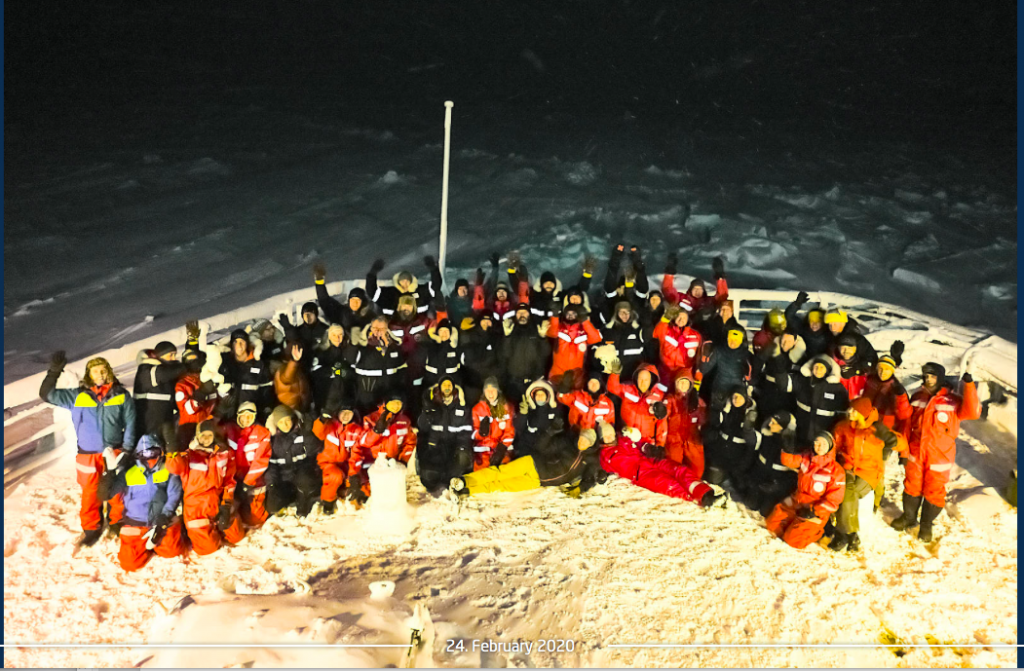26 February 2020
This past Monday marked the end of my 4th week on the Kapitan Dranitsyn. Our progress towards the Polarstern has been very slow due to thick ice, but we are now within 30 miles of the Polarstern and I hope to be onboard that ship in another few days. Everyone on the Dranitsyn is excited to get to the Polarstern and start our research. To celebrate getting close to the Polarstern we took a group photo on the back deck of the Dranitsyn late last week.

The slower than expected transit through the sea ice has created a number of problems. The biggest is that the Dranitsyn is beginning to run low on fuel for the return voyage to Tromsø. The Alfred Wegner Institute (AWI), that is running the expedition and operates the Polarstern, has been working hard over the past couple of weeks to develop contingency plans to make sure that we can get to the Polarstern and the scientists that have been on the Polarstern since December can get home.
To address the issue of the dwindling fuel supply on the Drantisyn AWI has contracted with another icebreaker to meet the Dranitsyn on its return voyage to Norway to refuel it. This means that we can continue to push north with the Dranitsyn without as much concern for the ship running out of fuel as it returns to Norway. This is a really important development because it greatly increases our chances of having the Dranitsyn reach the Polarstern.
The captain on the Dranitsyn has also decided that when the ice conditions are not favorable the Dranitsyn will stop pushing north and wait for the ice to improve to save fuel. By waiting rather than sailing the ship uses less than 10% of the fuel it would while breaking ice. The ice conditions change daily as the wind changes. Sometimes the wind blows in such a way that the ice is squeezed together and this makes it difficult for the icebreaker to make forward progress. Over the last week we’ve had two storms that have increased the pressure on the ice so we’ve had a few 12+ hour periods where we’ve drifted with the ice. These storms have been accompanied by winds of 30 to almost 70 mph. Usually, during these storms the temperature rises and we’ve had some periods with temperatures into the teens F. Currently, the wind is blowing at 40 mph with a temperature in the negative single digits F and a windchill temperature well below -40 deg F. Luckily, we don’t have any work to do outside so we can watch the wind and blowing snow from the comfort of inside the ship.
If the ice, weather or fuel prevents the Dranitsyn from reaching the Polarstern then the scientists onboard the Dranitsyn will be shuttled to the Polarstern by helicopter. This option will be time consuming since only 3 people can be transported on the helicopter at one time and we need to wait for good weather to do these flights. Using the helicopter to shuttle us to the Polarstern will also limit the amount of gear and cargo we can bring with us. Today we had our first helicopter flight shuttle between the Polarstern and Dranitsyn so two of the scientists from the Dranitsyn are now on the Polarstern.
Finally, AWI has reached an agreement with a Canadian company, Ken Borek, to use ski-equipped Twin Otter aircraft to help with the transfer if needed. Ken Borek is based in Calgary and the Twin Otter planes will fly from Calgary to Eureka, Canada and from there to the Polarstern, where a runway has already been prepared on the sea ice. The Twin Otter will then do shuttle flights between the Polarstern and Dranitsyn to transfer people and cargo. The Twin Otter is a small, twin engine plane well suited for flights in rugged conditions and has a much greater carrying capacity than the helicopters. Twin Otters are one of the main aircraft used for field work in Antarctica and I’ve flown on them many times before. These planes can land on ungroomed snow or ice surfaces making them ideal for reaching us as we drift through the sea ice on the Dranitsyn.

Currently we are north of 88 deg N latitude, less than 100 miles away from the North Pole and about 30 miles away from the Polarstern. The closer we can get to the Polarstern the easier and faster the helicopter transfer option will be, but we are hoping that the Dranitsyn can reach the Polarstern and allow us to walk across the sea ice from one ship to the other.
Between the extra fuel we can now use on the Dranitsyn and the two air transfer options we are all optimistic that we’ll all be on the Polarstern in a few more days. Hopefully my next blog post will be from the Polarstern.
John
